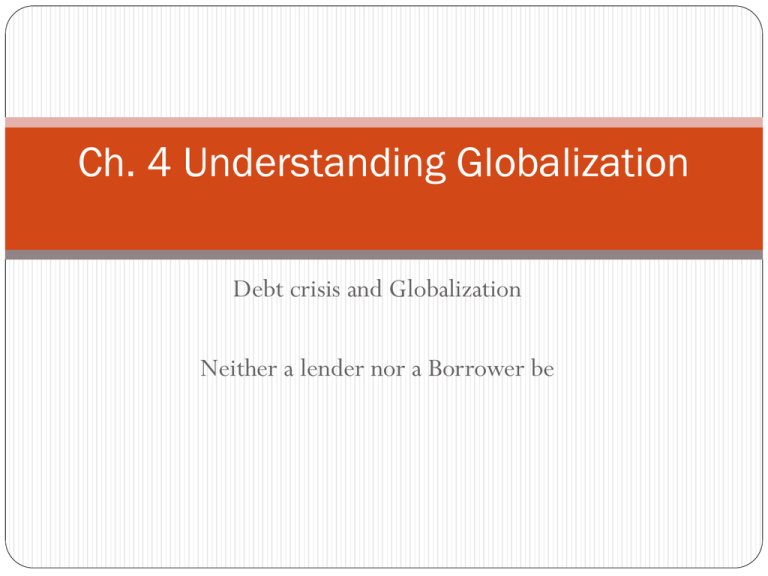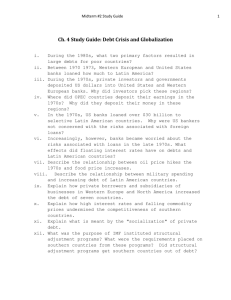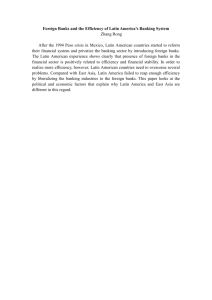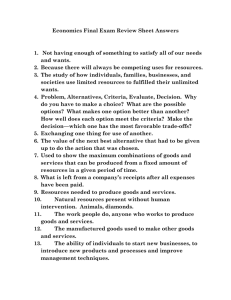Ch. 4 Understanding Globalization
advertisement

Ch. 4 Understanding Globalization Debt crisis and Globalization Neither a lender nor a Borrower be Debt crisis in early 1980s threatened rich and poor countries different consequences for northern creditors and southern debtors. Rising interest rates increased amount borrowers were expected to pay northern lenders and falling commodity prices for goods southern countries exported to North decreased incomes in South, make it more difficult for them to repay northern lenders. Increasing costs and falling incomes made it difficult for borrowers to repay debts Between 1970 and 1973, banks in Western Europe and United States lent $23.4 billion to Latin America, more money than had been loaned previous 30 years (Schaeffer, 81). The Lenders During 1970s governments and private investors deposited US dollars and other hard currencies they earned in trade with United States in Western European (WE) banks and in US banks with subsidiaries in Europe (Schaeffer, 81). Why did investors pick WE and U.S. to invest? Eurodollar banking pool grew from $10 billion in 1960 $210 billion in 1970. After the OPEC oil embargo raised oil prices, OPEC countries deposited profits in Western European and US banks (Schaeffer, 82). US banks became active in Latin America 1984 "in nine largest US banks loaned over $30 billion to private and government borrowers in three countries: Mexico, Brazil, and Argentina (Schaeffer, 82). The Lenders Loaned so poor countries purchase goods made in Western Europe and North America in 1970s: 42% of Britain's construction equipment, 33% of new aircraft and 32% of textile machinery went to third world markets; in US, by 1980 third world markets accounted for 20% of US industrial product and one quarter gross farm income (Schaeffer, 82). US bankers and 1970s did not worry about risks associated with foreign loans: most money was loaned to Latin American dictatorships and price of oil was rising in 1970s, as incomes grew, borrower countries would repay old debts, and countries do not go bankrupt. The Lenders Northern banks worried about risks associated with debts, however. Late 1970s borrower agreed to readjust interest rates on new and old loans every six months in line with current market rates. By 1983, 70% of all loans in Latin America were subject to floating interest rates, rising or falling depending on interest rates set in the United States (Schaeffer, 83). The Borrowers Latin America borrowed $272 billion between 1976 and1981 60%, $170.5 billion was paid back to banks as debt repayment or interest $23 billion remained with [northern]banks as reserves and $56.6 billion sent abroad as capital flight; of the $88 billion dollars Mexicans borrowed between 1977 and1979, $14.3 billion was available for use in country; (Schaeffer, 84). The Borrowers Rising oil prices and 1970s force countries without oil to pay more for imported oil; oil price increases cost southern countries an extra $260 billion between 1974 1982 (Schaeffer, 84). Imported food rose in 1970s. Rising oil prices increased cost of growing food with farmers relying heavily on gasoline – powered tractors and petroleum – based fertilizers and pesticides; Poor harvests and Soviet union during mid-1970s increased demand and price of food on world markets; The Borrowers Military spending by Latin American countries doubled during 1970s, despite facing no external threats(Schaeffer 85). Failed development projects and government corruption also increase debts; private borrowers acquired a substantial portion of Latin American debt. Private debt rose from $15 billion in 1972 to $58 billion in 1981. Non-Government Sources of Debt Private debt rose from $15 billion in 1972 to $58 billion in 1981 Subsidiaries of businesses in Western Europe and North America borrowed money; GM, Ford, PepsiCo, added $70 million to Mexico’s debt total;(Schaeffer, 85-86). Causes of increased private debt were high interest rates and falling commodity prices Rising Interest Rates and Falling Prices High-interest rates increased debt; Mexico’s interest went from $2.3 billion in 1979 to $6.1 billion in 1982; For Latin America in total: $14.4 billion in 1979 to $36.1 billion in 1982; Economist estimate that 1980s high-interest rates cost LA countries $41 billion more than they would have paid if rates remained at avg level between 1960 and 1980; High-interest rates attracted $150 billion in LA capital between 1973 and 1987 (Schaeffer, 87). Falling Prices Commodity price levels fell between 1950 and mid-1970s; Between 1980 and 1982, world commodity prices fell by a third; Falling prices reduced ability of borrowers to repay debs being pushed up by higher interest rates; Commodity prices fell as southern countries produced mor in the 1980s (Schaeffer, 88). IMF and Structural Adjustment Programs(SAPs) Capital flows to LA fell by one-third from 1980 and 1984 but countries needed new loans; Purpose of SAPs was to create trade surpluses and government surpluses to repay debts; LA governments devalued their currency to try and create trade surpluses and become competitive; LA countries exported between $90 billion and $100 billion worth of goods between 1980 and 1984; money used to repay lenders (Schaeffer, 92). IMF and Structural Adjustment Programs(SAPs) Mexican govt. sold off 875 of 1,155 enterprises that it had owned in 1982 (Schaeffer, 93); Mexican govt. sold Telefonos De Mexico for $1.76 billion to a French, American, and Mexican communications consortium; Benefits for the North—Lenders paid back by southern borrowers; Increased flow of goods from South to North; Sales of industries in South; northern investors got great bargains;







